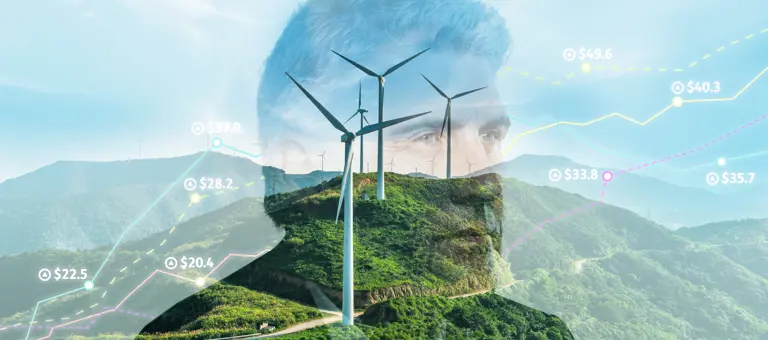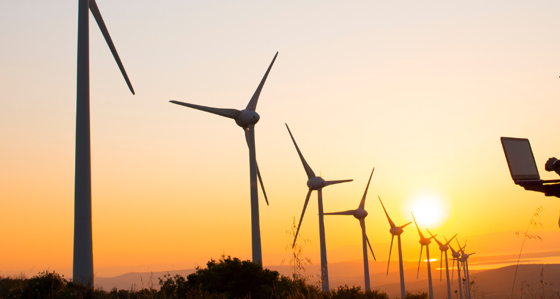
The future cost of wholesale energy
8 October 2021
The latest policy announcements from Boris Johnson are another exciting development in the transition to a net zero economy by 2050 and recognise the hugely important role that renewable electricity generation has to play in achieving the ambitious decarbonisation targets.
It comes at a time when UK consumers are facing inevitable rises in household energy bills over the next two to three years averaging circa £500 per household, primarily due to the rise in global gas prices.
The real cost of energy
Today, the wholesale price contributes just under 40% of the total household electricity bill, with the remainder coming from environmental levies, network charges and other system costs, and also a tiny slither of profits to the supply companies themselves. Whilst we expect the profit margins to all but disappear in the next few months for the majority of retailers, the component over which we have virtually no control of in the UK - the wholesale price component - will rise dramatically and account for upwards of 50% of the consumer's final power bill.
This extraordinary recent rise in wholesale prices driven by global gas pricing, comes at the worst possible time in the energy transition from the perspective of consumers: the subsidy payments for renewables are a significant cost to consumers, but paradoxically we do not have enough renewables yet in the system today, to decouple us from the exposure to global commodity (and primarily gas) prices.
In effect we have the double whammy of paying the high subsidies, but not yet realising the benefits in lower wholesale costs. We should be clear though: some subsidy to the renewable industry – particularly offshore – was a prerequisite to the development of the effective supply chains and growth of the offshore industry we see today, and consumers will see benefits in the long term with lower and more stable retail pricing. Perhaps pricing for consumers will transition away from a unit charge to a monthly service charge – analogous to broadband.
Funding low carbon power generation
Boris Johnson is confident that we can get there by the mid-2030s and we admire the intent. We will be examining the scenarios and pathways that could get us to this outcome in future editions of our wholesale market analysis.
Our latest projections have low carbon generation already contributing around 85% of demand by 2035, with a capital investment over the next decade of around £50bn. To meet the Government targets by 2035 at least an additional £20bn of investment in Low Carbon generation will be needed. The generation mix certainly won’t be purely renewables and as a society we will be dependent on new forms of nuclear, potentially hydrogen and abated gas to provide flexibility to mitigate the growing intermittency from role, and of course an increased role for interconnection to our neighbours – an asset class with its own political challenges.
Balancing today's demand with tomorrow's future
In coming up with the latest commitments, we are curious to the assumptions being made with respect to electrification of heat and transport. Whilst meeting today’s demand through low carbon generation is a realistic, albeit challenging target, there is potential for massive additional demand for electricity coming from heating and transport: The current fuel crisis will simply have accelerated the pace of conversion from petrol and diesel. Each additional electric vehicle on the road, will put a higher target on the amount of renewable capacity to meet demand in the 2030s. It may add up, but a lot of things need to go well over the next decade.
In the meantime, the Government does need to make sure that in the transition to a ‘Green’ power sector (however that is defined…), the lights do actually remain on. For any Government a major blackout caused by a fundamental shortage of capacity, would be a huge embarrassment – with far more near term damage politically than failing to meet a carbon reduction or renewable generation target.
And our existing fleet of gas-fired generation has a huge role to play here over the next decade or so. The owners of these gas plants will fully appreciate the long term decarbonisation targets and that the role these assets currently play in the system will change dramatically. But in signalling the long term intent for the mid-2030s, we do need to ensure that the existing fleet does not close prematurely: it would be a very undesirable consequence and we hope this has been fully factored into the recent announcements.
Contact Phil Grant, Global Lead for Power Generation for more information on our energy analysis across global power, gas and carbon markets and to discuss how we can help your organisation.
Our Experts

Related Insights

Synchronisation of the Baltic power system with Continental Europe opens exciting opportunities for batteries
The synchronisation of the Baltic power system with continental Europe is a significant milestone that opens exciting opportunities for batteries.
Read more
Renewables Market Scanning Report
Which are the most attractive markets for investing in renewable assets globally?
Read more
How can investors and developers capitalise on South Korea’s evolving energy market?
South Korea's energy market is transforming in line with the global shift to renewable energy.
Read more
How ‘Equipment-as-a-Service’ models unlock commercial decarbonisation
Read our latest piece, created in collaboration with Tallarna, to explore the components of an ‘Equipment-as-a-Service’ model, how they can be deployed, and how to increase take-up.
Read moreIs digital and AI delivering what your business needs?
Digital and AI can solve your toughest challenges and elevate your business performance. But success isn’t always straightforward. Where can you unlock opportunity? And what does it take to set the foundation for lasting success?